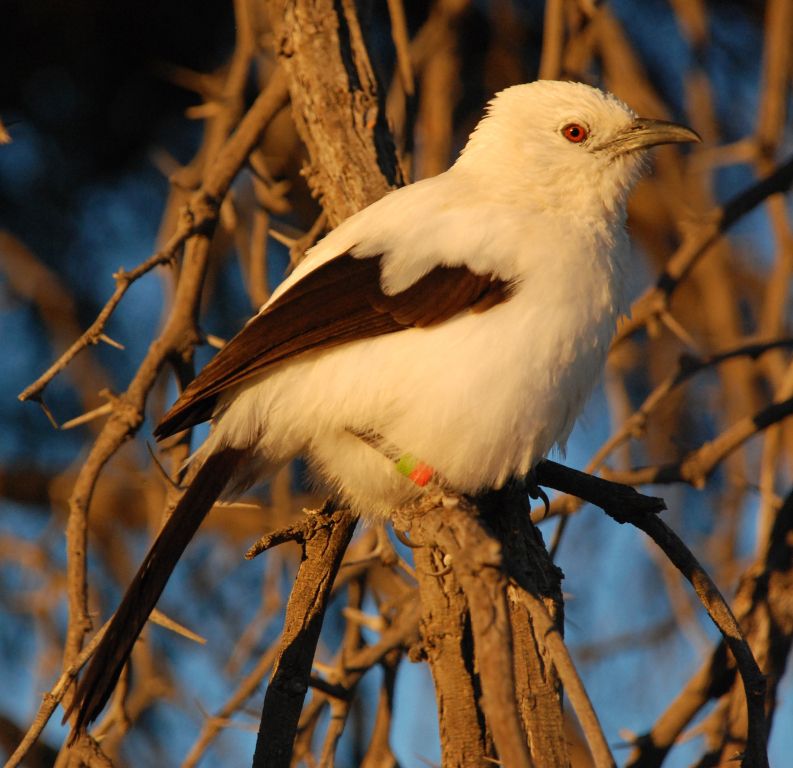This Bird Tricks Other Animals Into Handing Over Their Meals
The African drongo mimics warning calls of other animals to scare them away from food, but mixes true warnings with lies to keep those animals guessing
:focal(1398x612:1399x613)/https://tf-cmsv2-smithsonianmag-media.s3.amazonaws.com/filer/f2/29/f2299739-5102-4847-b9e5-f2d57c0633c0/drongo.jpg)
We humans are exceedingly bad at recognizing when we’re being deceived. Yet comfort of sorts can be found in the animal kingdom—animals, too, fall victim to trickery at the hands of other creatures, from being fooled into raising another species’ young to failing to spot a trap designed to turn them into dinner.
Visual lies, however, are not the only form of deception that animals enlist to fool others into doing what they want. One clever African bird called the forked-tailed drongo has evolved the ability to mimic the calls of other species, including other types birds and meerkats. When the drongo spots a coveted tasty morsel in the paws or claws of another creature, it simply mimics the warning call of that animal. For a human, this would be like yelling, “Fire! Fire!” at a restaurant, and then slinking back in to eat all of the unattended food after the panicked diners had run away.
Ornithologists already knew that drongos were highly skilled vocal thieves, but they weren’t sure how the birds were able to continuously pull off those meal-snatching crimes. Just as humans who repeatedly catch another person in a lie learn not to trust that individual, animals, too, are usually quick to catch on—especially when it comes to something as important as whether or not they get to eat that day. If an animal is tricked enough using the same deception, eventually it will catch on. So why do these animals repeatedly fall for the drongo’s ploy?
To find out how the drongos keep their victims from habituating, a team of international researchers traveled to the Kalahari Desert in southern Africa. They spent more than 800 hours in the field, meticulously watching 64 of the birds and recording their calls and behaviors. Through this, the researchers witnessed around 700 attempted food robberies.
After analyzing the drongo call recordings and comparing them with behavior notes, the researchers discovered that the bird’s secret to success is quite complicated, as they report in Science. Drongos, it turns out, are capable of producing a number of alarm calls; some individuals had a repertoire of more than 30. Six of them are their own drongo-specific alarm calls, which they make when a real predator is present. Other species eavesdrop on this call and take it seriously, essentially using the drongos as unpaid bodyguards.
Additionally, the birds mimic the alarm calls of target species themselves. Throughout the day, drongos will pick a victim and then combine various calls to report both truth and lies—a strategy ecologists call tactical deception. They sometimes warn of a real predator and sometimes warn of a fake one, and for any given vocalization will switch between drongo-specific calls and an arsenal of mimicked ones.

To get at the root of how effective this system really is, the researchers played a number of alarm calls to pied babblers—common victims of drongo deception. They played drongo alarms, drongo-mimicking-babbler alarms, true babbler alarms and warning calls from starlings. The babblers, they found, responded more intensely to the drongo-mimicked than to the drongo-specific calls. They also responded more to drongo calls that contained three different mimicked babbler warnings rather than the same babbler warning repeated over and over again.
But the babblers responded even more strongly when they heard their own warning calls or the starling’s warning calls, showing that they might be catching on to the fact that the drongos are sometimes little liars. However, as the researchers point out, so long as drongos continue to mix it up and target a variety of species, the strategy seems to work well.
By keeping it fresh, drongos make sure that their multi-species targets can never quite figure out what they’re up to, thus enabling their own freeloading lifestyle. All in all, the researchers found, drongos acquire more than 20 percent of their food this way. Not bad for a bird who cries wolf.
/https://tf-cmsv2-smithsonianmag-media.s3.amazonaws.com/accounts/headshot/Rachel-Nuwer-240.jpg)
/https://tf-cmsv2-smithsonianmag-media.s3.amazonaws.com/accounts/headshot/Rachel-Nuwer-240.jpg)